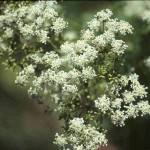Poison Hemlock
Conium maculatum
Apiaceae (Parsley family)
Description
NOTE: All parts of Poison Hemlock are extremely poisonous. Ingesting even small amounts can be fatal to man and livestock. Poison Hemlock is a biennial of the carrot family (Apiaceae). It has stout, erect, hollow, and light green stems that may be purple-streaked or splotched and may grow to up to 10 ft or 2.5 m tall. It has a long, white penetrating taproot. In favorable locations, it can be a perennial. Normally in year one, it produces a basal rosette and a flowering stem in year two. Leaves can reach up to 4 cm wide by 50 cm long with many oval to broadly-oval leaflets opposite each other. The leaf stems clasp the main stem at their junction. The leaves are three times pinnately divided giving the plant a fern-like appearance. All parts of the plant, including the leaves, are hairless. The upper leaf surfaces appear filmy. White flowers are arranged in umbrella-shaped clusters. The compound umbel can be terminal or axillary and up to 15 cm across. It is composed of 8-18 umbellets, each with 12-15 five-petaled flowers. Flowering generally occurs from late spring to early summer. Flowers produce a green, deeply ridged fruit that matures to grayish brown.Habitat
Poison Hemlock is an introduced Eurasian species brought to the United States as an ornamental plant for its attractive white flowers. It has become very common in the Edwards Plateau along creeks and bottomlands. These plants can be found in dense stands in roadside ditches and stream banks in the southern half of Texas. It grows in moist soils preferring full sun to light shade.Toxic Agent
Poison Hemlock contains piperidine alkaloids including conine. The stems and leaves are the most toxic parts of the plant. Cattle and swine are the species affected most often, but it is toxic to all mammals including sheep, goats, donkeys, rabbits, and horses. This plant is hazardous to humans and was used in political executions in ancient Greece (Socrates). Cattle seldom graze the plant but may be poisoned by it in hay or green chop. The roots or young leaves may poison swine. Hay containing Poison Hemlock is considered hazardous. Animals die from respiratory paralysis in two to three hours. A human ingesting six to eight fresh leaves (about 0.1 gm of conine) can die in two hours. Poisoning can also result from inhaling its fumes or through skin contact.Signs of Livestock Ingestion
Signs of acute poisoning occur within a few hours of consumption; these include initial stimulation followed by progressive central nervous system depression. Stimulation: Nervousness; Muscle tremors; Incoordination; Salivation; Colic. Depression: Partial paralysis; Slow heart rate; Low body temperature; Slow respiration rate; Coma; Death. Low-level intake during a specific period of gestation (50 to 75 days in cattle) may cause birth defects, mainly malformations. "Crooked calf disease" may include cleft palate and skeletal deformities. The amount of plant needed to produce birth defects may not be enough to cause illness in the dam.Management Strategies
Do not cut hay or green chop from areas containing this plant. This is especially of concern when roadsides are used to harvest low-quality hay during drought. Severely poisoned animals may be given stimulants and supportive care. Artificial ventilation for 48 to 72 hours may prevent death. Control with herbicides is suggested. If hand pulling, wear gloves.Images
Plant Characteristics
Flower Color: White
Seed Type: Non-Encapsulated
Duration: Biennial
Stem Texture: Hairless/Smooth
Growth Habit: Forbs/Broadleaf
Leaf Shape
 : Pinnately Compound
: Pinnately Compound
Season: Warm
Distribution
 : 02 - Gulf Prairies and Marshes, 03 - Post Oak Savannah, 04 - Blackland Prairies, 05 - Cross Timbers and Prairies, 07 - Edwards Plateau, 10 - Trans-Pecos
: 02 - Gulf Prairies and Marshes, 03 - Post Oak Savannah, 04 - Blackland Prairies, 05 - Cross Timbers and Prairies, 07 - Edwards Plateau, 10 - Trans-Pecos
Distributions
Distribution refers to the ecological region in Texas that a plant has been found. You can also view a clickable map.
Book: Toxic Plants of Texas (B-6105)
Collection: Toxics, Wild Flowers
Livestock Affected: Cattle, Goats, Horses, Pigs, Sheep
Livestock Signs: Abdominal Pain, Abnormal Heartbeat, Birth Defects, Colic, Coma, Depression/ Weakness, Excess Salivation, Excitability, Incoordination, Irregular Breathing, Stiffness, Trembling





